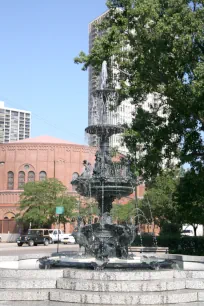Lincoln Park is Chicago’s largest park, covering an area of about 1200 acres (486 ha) just north of the city’s downtown area. It stretches for six miles (10 km) along the lakefront between North Avenue to the south and West Ardmore Drive to the north.
The park is less formal than Chicago’s most famous parks, the urban Grant Park and glitzy Millennium Park.
The Park

Lincoln Park is a favorite with Chicagoans, especially during the summer months, partly thanks to the many beaches found in the park. The most popular are Fullerton Avenue Beach – located near the lively neighborhood around the DePaul University – and North Avenue Beach. Here you’ll often find a Californian atmosphere with plenty of sunbathers, swimmers and beach volleyball players. There’s also a large Beach House in the shape of an ocean liner.
Besides the beaches, the park also boasts yacht-basins, a golf course, a couple of ponds and a number of walking paths and biking trails; the lakefront trail leads all the way to Jackson Park on the south side.
Lincoln Park Zoo


Most of Lincoln Park’s attractions can be found at the southern half of the park. The most popular attraction here is the free Lincoln Park Zoo. The Regenstein African journey, which guides you along the habitats of apes and other African animals, is one of the most interesting parts of the zoo. Other highlights include the Lion House and the Polar Bear pool.
At the southern end of the zoo lies the “Farm in the Zoo”, a working farm where children can witness demonstrations of cow milking and butter churning.
At the opposite end of the zoo you’ll find the magnificent Lincoln Park Conservatory, a glass nineteenth-century building where you can admire a large number of exotic plants.
Nearby the conservatory is the picturesque Caldwell Garden, a historic lily pool garden with a Prairie style pavilion. Keeping with the nature theme is the Peggy Notebaert Museum across Fullerton Parkway, a hands-on museum focused on nature and environmental issues.
Chicago History Museum

Another museum in the area is the Chicago History Museum, located at the southwest edge of the park. A number of interesting exhibits highlight the growth of the city of Chicago from a trading post to a metropolis. Many important milestones in the history of Chicago are covered, including the Great Fire of 1871, the exhibitions of 1893 and 1933-34, and the notorious 1968 convention. The Chicago Room shows the city’s influence in architecture and design.

Lincoln Statue
Not far from the museum stands the most famous of the five Lincoln Statues that were erected in Chicago in honor of Illinois’ native son.
The statue, known as the “Standing Lincoln” was designed by Augustus Saint-Gaudens – who also created the “Sitting Lincoln” statue in Grant Park. The statue is considered Saint-Gaudens’s best work and shows the sixteenth President sunk into deep thought, presumably shortly before delivering a speech. The statue was sculpted after Lincoln was assassinated, so Saint-Gaudens used plaster casts that had been made from the president’s hands and face as a model for the statue.
Couch Mausoleum

Just west of the Lincoln Statue stands the Couch Mausoleum, the most notable reminder of Lincoln Park’s past use as a cemetery.
The white limestone Mausoleum was built in the nineteenth century for Ira Couch, a successful hotelier. When he died in 1857, the mausoleum was erected at the cemetery by his family. Just three years later, however, the city of Chicago decided to close the cemetery for sanitary reasons, and it started to move the bodies to other cemeteries. For some reason, the mausoleum stayed put. It is not the only remnant of the old cemetery. A number of bodies, many of them from a Civil War era prisoner of war camp, were never moved and are still buried in this area.

Lincoln Park neighborhood
The neighborhood just west of Lincoln Park is named after the park. There are no real attractions to speak of in the area, but it is one of the city’s most pleasant neighborhoods thanks to the many historic rowhouses and tree-lined streets.
The area around the DePaul University attracts a young crowd, creating an often vibrant atmosphere. Here you’ll find an interesting choice of diverse restaurants and original boutiques, in contrast to the more upscale Magnificent Mile where all the large national chains are present.

